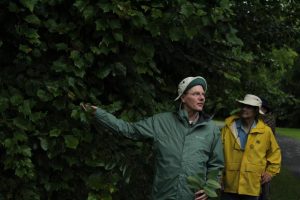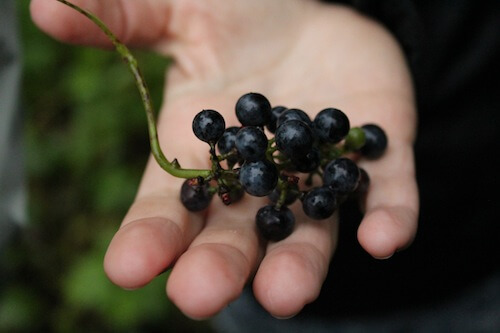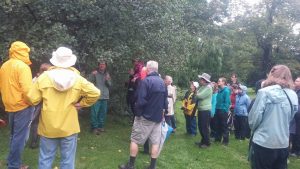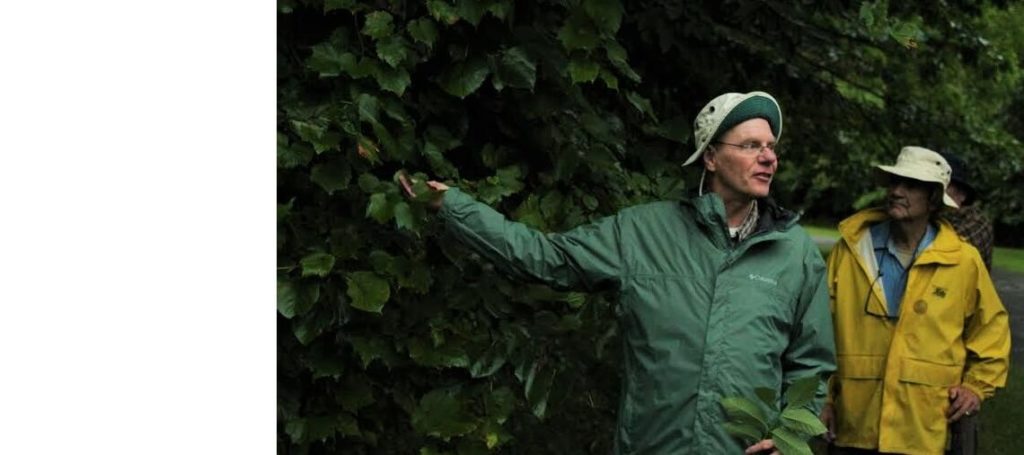
“Learn them, love them, protect them,” Jim Goltz quoted his late friend, Hal Hinds, at a guided walk of Odell Park that opened the Conservation Council’s 5 Days for the Forest event on Sept. 19. Hinds wrote those words in Goltz’s copy of Hinds’ botanical reference guide book, The Flora of New Brunswick.
Almost 40 people braved the rain for an opportunity to hear Jim Goltz brighten up the evening with his knowledge and infectious awe of the forest in Odell Park.
A cup of chaga tea, donated by Real Food Connections, warmed up the walkers before their adventure. Chaga grows on our yellow birch and is a fungus known for its restorative health properties, high in anti-oxidants and vitamins.
Goltz pointed out the old white pine and hemlock trees in Odell Park found in The Great Trees of New Brunswick book published in 1972. The Conservation Council is working with David Palmer, another Fredericton local who knows his trees, on a second edition of the book.

Did you know that there are native grapes found in our forest? Walkers had an opportunity to taste riverbank grapes in Odell’s forest as well as learn the differences between the ashes, a white ash and black ash, and the maples – a striped maple, sugar maple, and red maple.
Basswood and hobblebush are also easy to confuse with their huge heart-shaped leaves but not when you hear Goltz explain the differences. The basswood has alternate leaves while the hobblebush has opposite leaves. Goltz remarked that the overwintering buds of hobblebush leaves are folded together and look like they are praying for spring.
The butternut tree that grows along the Saint John River valley is Goltz’ favourite tree. Unfortunately, this walnut tree species with its edible butternuts is often infected by a canker that currently threatens its existence. Beech trees are also infected by a disease, an insect-fungus complex that disfigures its bark. Goltz spoke with regret for how humans have affected these trees and changed nature.
While sharing the history of the trees and their uses, Goltz admitted that he would have loved to have been an ethnobotanist, travelling the world learning more about plants and how they have been used by humans for generations.

Goltz reminded us that Odell Park is a special forest, with some of the oldest trees in New Brunswick, a place to be enjoyed in the different seasons. In the spring, trilliums, jack-in-the-pulpit, lady’s slippers and other flowers grow there, while in the fall, a variety of colourful mushrooms grow on the moist forest floor.
Goltz ended the walk with a serious message for Odell Park. The park’s future is currently contested and the subject of future public consultations for the creation of a management plan. Different users have varying opinions of how the forest should be used. Some argued that its current state should be conserved while others want the trails to be developed for mountain biking and areas opened up for disc golf.
Odell Park allowed Goltz to share his knowledge of trees, how old forest ecosystems work, like how dead and decaying trees are important to forest life, and how storms create spaces in the forest canopy for the trees that need sunshine to grow up. He wants to see the park conserved and encourages everyone to learn, love and protect their forest.

